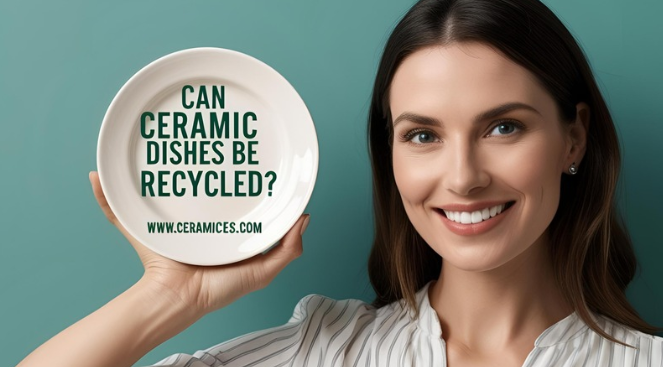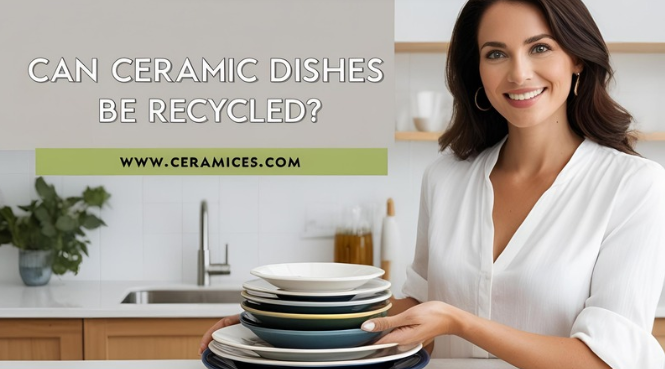Ceramic dishes are a staple in many households, cherished for their durability, aesthetic appeal, and versatility. However, as sustainability becomes an increasingly important concern, many people are wondering, “Can ceramic dishes be recycled?” This article will explore the recyclability of ceramic dishes, the challenges involved, and alternative options for disposing of them responsibly. Whether you’re a homeowner, a sustainability enthusiast, or simply someone looking to reduce waste, this guide will provide you with all the information you need about recycling ceramic dishes.
What Are Ceramic Dishes?
Ceramic dishes are made from clay that is shaped, glazed, and fired at high temperatures to create durable and functional tableware. They are commonly used for serving food and beverages and come in various forms, including plates, bowls, mugs, and platters.
Key Components:
- Clay Body: The base material that gives the dish its shape and structure.
- Glaze: A glass-like coating applied to the dish to make it waterproof and add color or design.
- Design: Ceramic dishes often feature intricate designs, patterns, or artwork.
Can Ceramic Dishes Be Recycled?

The recyclability of ceramic dishes is a complex issue. Unlike materials like glass, paper, and certain plastics, ceramics are not easily recyclable through standard municipal recycling programs. Here’s a detailed look at why recycling ceramic dishes is challenging and what options are available:
1. Material Composition
Ceramics are made from a combination of natural materials like clay and silica, which are not easily separated and processed in standard recycling facilities.
2. Glaze
The glaze used on ceramic dishes can complicate the recycling process. Glazes often contain chemicals and pigments that can contaminate the recycling stream.
3. High Melting Point
Ceramics have a high melting point, making them difficult to melt down and reform into new products, unlike materials like glass or metal.
4. Contamination
Ceramic dishes can be contaminated with food residues, which can further complicate the recycling process.
Challenges in Recycling Ceramic Dishes
Recycling ceramic dishes presents several challenges, including:
1. Lack of Infrastructure
Most municipal recycling programs are not equipped to handle ceramics, as they require specialized facilities and processes.
2. Economic Viability
The cost of collecting, sorting, and processing ceramics often outweighs the economic benefits, making it less attractive for recycling facilities.
3. Quality Degradation
Recycled ceramics often have lower quality and strength compared to virgin materials, limiting their usability in new products.
4. Contamination Issues
Food residues and glazes can contaminate the recycling stream, making it difficult to produce high-quality recycled materials.
Alternative Options for Disposing of Ceramic Dishes
While recycling ceramic dishes through standard municipal programs may not be feasible, there are several alternative options for disposing of them responsibly:
1. Donation
If your ceramic dishes are still in good condition, consider donating them to local charities, thrift stores, or community centers. This extends their lifespan and reduces waste.
2. Repurposing
Get creative and repurpose old ceramic dishes into new items. For example, broken pieces can be used for mosaic art, garden markers, or DIY projects.
3. Specialized Recycling Programs
Some specialized recycling programs and facilities may accept ceramics. Check with local waste management authorities or recycling centers to see if they offer ceramic recycling services.
4. Upcycling
Upcycling involves transforming old or unwanted items into new, useful products. Consider upcycling ceramic dishes into planters, candle holders, or decorative pieces.
5. Landfill
As a last resort, ceramic dishes can be disposed of in a landfill. While this is not the most environmentally friendly option, it may be necessary if no other alternatives are available.
How to Prepare Ceramic Dishes for Recycling or Donation

If you decide to recycle or donate your ceramic dishes, follow these steps to prepare them:
1. Clean Thoroughly
Ensure the dishes are clean and free from food residues. Wash them with warm, soapy water and dry them completely.
2. Inspect for Damage
Check the dishes for any cracks, chips, or damage. Damaged dishes may not be accepted for donation and may need to be repurposed or disposed of.
3. Separate Components
If the dishes have any non-ceramic components, such as metal rims or handles, remove them before recycling or donating.
4. Pack Securely
Pack the dishes securely to prevent breakage during transport. Use bubble wrap, newspaper, or other protective materials.
5. Label Clearly
If donating, label the box clearly with the contents and any relevant information, such as the number of items and their condition.
Environmental Impact of Ceramic Dishes
Understanding the environmental impact of ceramic dishes can help you make more informed decisions about their use and disposal:
1. Durability
Ceramic dishes are highly durable and can last for many years, reducing the need for frequent replacements and minimizing waste.
2. Energy-Intensive Production
The production of ceramic dishes is energy-intensive, involving high-temperature firing processes that consume significant amounts of energy.
3. Non-Biodegradable
Ceramics are non-biodegradable, meaning they do not break down naturally in the environment. This makes proper disposal and recycling important.
4. Resource Extraction
The extraction of raw materials like clay and silica can have environmental impacts, including habitat disruption and resource depletion.
FAQs: Can Ceramic Dishes Be Recycled?
1. Can ceramic dishes be recycled?
Ceramic dishes are not easily recyclable through standard municipal recycling programs due to their material composition and high melting point.
2. Why are ceramics difficult to recycle?
Ceramics are difficult to recycle due to their high melting point, contamination issues, and lack of specialized recycling infrastructure.
3. What should I do with old ceramic dishes?
Consider donating, repurposing, or upcycling old ceramic dishes. If no other options are available, they can be disposed of in a landfill.
4. Can I donate broken ceramic dishes?
Most charities and thrift stores do not accept broken or damaged dishes. Consider repurposing or upcycling them instead.
5. Are there specialized recycling programs for ceramics?
Some specialized recycling programs and facilities may accept ceramics. Check with local waste management authorities or recycling centers for more information.
6. How can I repurpose ceramic dishes?
Broken ceramic dishes can be repurposed into mosaic art, garden markers, planters, or decorative pieces.
7. What is the environmental impact of ceramic dishes?
Ceramic dishes are durable and long-lasting, but their production is energy-intensive, and they are non-biodegradable.
8. Can I recycle ceramic dishes with metal components?
Metal components should be removed before recycling or donating ceramic dishes, as they can complicate the recycling process.
9. How do I prepare ceramic dishes for donation?
Clean the dishes thoroughly, inspect for damage, remove non-ceramic components, pack securely, and label clearly.
10. Are there any eco-friendly alternatives to ceramic dishes?
Eco-friendly alternatives to ceramic dishes include bamboo, stainless steel, and glass tableware, which are more easily recyclable.
Conclusion: Can Ceramic Dishes Be Recycled?
While ceramic dishes are not easily recyclable through standard municipal programs, there are several alternative options for disposing of them responsibly. Donating, repurposing, and upcycling are excellent ways to extend the lifespan of ceramic dishes and reduce waste. Specialized recycling programs may also be available in some areas, offering a more sustainable disposal option.
So, the next time you ask, “Can ceramic dishes be recycled?” remember that while recycling may not always be feasible, there are plenty of creative and eco-friendly ways to give your old dishes a new lease on life. By making informed decisions about the use and disposal of ceramic dishes, you can contribute to a more sustainable and environmentally friendly future. Whether you’re donating, repurposing, or upcycling, every effort counts in reducing waste and preserving our planet’s resources.
Read more
1 Can you Recycle Ceramic? Ceramic Recycling Methods
2 How to Recycle Ceramic: The Complete Guide for Sustainable Living
3 Are Ceramic Mugs Microwave Safe? Using Ceramic Mugs in the Microwave